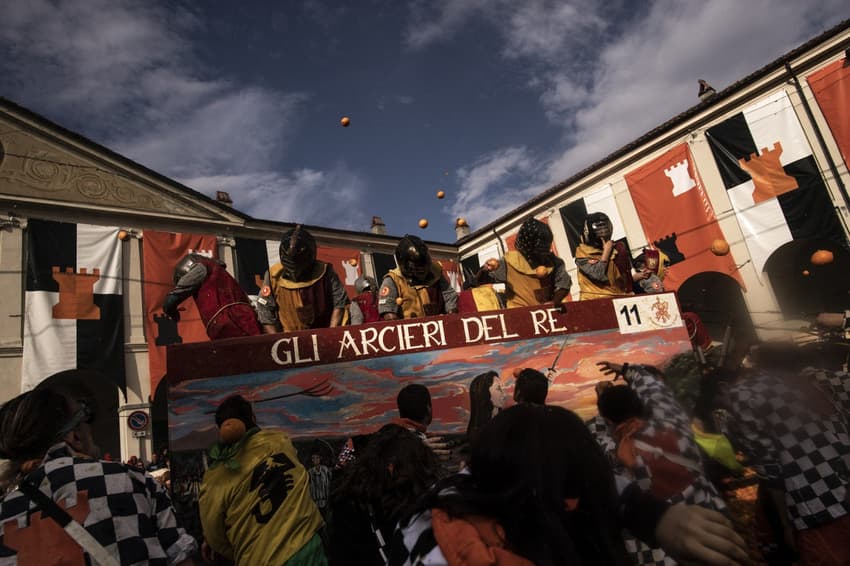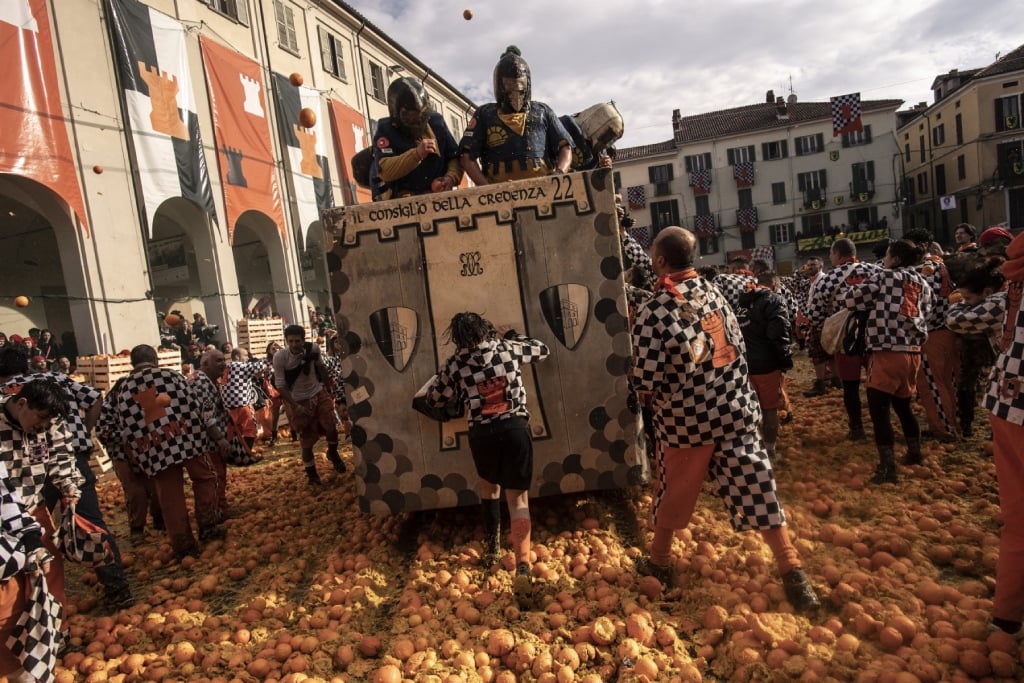Why does the Italian town of Ivrea hold a ‘battle of the oranges’?

Every year the town of Ivrea, in Italy’s Piedmont region, holds one of the most peculiar carnival festivals in the country as thousands of people take part in a ferocious three-day ‘orange battle’ – but why do they do this?
Italy likes to go all out when it comes to carnival celebrations as towns up and down the country stage dazzling parades of papier-maché floats and a host of masked revelries in the days leading up to Shrove Tuesday, falling on February 13th this year.
There’s one town in northern Italy however that likes to celebrate carnevale quite differently from the rest of the peninsula.
Located just north of Turin in the Piedmont region, Ivrea is a small town of around 23,000 people which normally enjoys an atmosphere of tranquillity and peaceful connection with nature.
But things are very, very far from tranquil during the local carnival festival as around 8,000 residents engage in a three-day ‘orange battle’ (Battaglia delle Arance), where nine teams of ‘orange throwers’ (or arancieri) on foot go toe-to-toe with ‘henchmen’ riding down the town’s main streets on shielded carts.

Orange throwers (or arancieri) are pictured during the traditional 'Battle of the Oranges' held during carnival in Ivrea, Piedmont. Photo by MARCO BERTORELLO / AFP
Contrary to what outsiders may be led to believe, the fight is no joke: over 600 tonnes of oranges (that’s over 4.2 million oranges) are thrown during the festival and dozens of participants every year seek medical attention from the on-site paramedics after suffering ‘orange-inflicted’ bruises and blows.
READ ALSO: Beyond Venice: Eight other carnivals to visit in Italy in February 2024
But what’s really behind this ferocious (and oddly vitamin C-based) clash?
The origins of the tradition are to this day a little murky but seem to trace back to a late 12th-century revolt.
According to local lore, Ivrea was then ruled by a tyrannical overlord who customarily abducted peasant women on their wedding nights and raped them.
One night however, a miller’s daughter (mugnaia in Italian) named Violetta managed to fight him off and decapitate him, starting a rebellion.
During the riots, peasants stormed the overlord’s palace and burned it to the ground.
Townspeople’s struggle for freedom is commemorated every year in the ‘orange fight’, where orange throwers on foot represent the rioting peasants, whereas those riding on carts represent the tyrant’s henchmen.

Orange throwers surround a cart during the 'Battle of the Oranges' in Ivrea, Piedmont. Photo by MARCO BERTORELLO / AFP
The three-day fight attracts hundreds of visitors from all over Italy every year but is also regularly criticised over food waste and the welfare of the horses pulling the henchmen’s carts.
After each day of battle, the smashed oranges are collected and stored in a specific tank.
The fruits are then transported to a plant that takes care of their disposal by transforming them into compost and energy.
Comments
See Also
Italy likes to go all out when it comes to carnival celebrations as towns up and down the country stage dazzling parades of papier-maché floats and a host of masked revelries in the days leading up to Shrove Tuesday, falling on February 13th this year.
There’s one town in northern Italy however that likes to celebrate carnevale quite differently from the rest of the peninsula.
Located just north of Turin in the Piedmont region, Ivrea is a small town of around 23,000 people which normally enjoys an atmosphere of tranquillity and peaceful connection with nature.
But things are very, very far from tranquil during the local carnival festival as around 8,000 residents engage in a three-day ‘orange battle’ (Battaglia delle Arance), where nine teams of ‘orange throwers’ (or arancieri) on foot go toe-to-toe with ‘henchmen’ riding down the town’s main streets on shielded carts.

Contrary to what outsiders may be led to believe, the fight is no joke: over 600 tonnes of oranges (that’s over 4.2 million oranges) are thrown during the festival and dozens of participants every year seek medical attention from the on-site paramedics after suffering ‘orange-inflicted’ bruises and blows.
READ ALSO: Beyond Venice: Eight other carnivals to visit in Italy in February 2024
But what’s really behind this ferocious (and oddly vitamin C-based) clash?
The origins of the tradition are to this day a little murky but seem to trace back to a late 12th-century revolt.
According to local lore, Ivrea was then ruled by a tyrannical overlord who customarily abducted peasant women on their wedding nights and raped them.
One night however, a miller’s daughter (mugnaia in Italian) named Violetta managed to fight him off and decapitate him, starting a rebellion.
During the riots, peasants stormed the overlord’s palace and burned it to the ground.
Townspeople’s struggle for freedom is commemorated every year in the ‘orange fight’, where orange throwers on foot represent the rioting peasants, whereas those riding on carts represent the tyrant’s henchmen.

The three-day fight attracts hundreds of visitors from all over Italy every year but is also regularly criticised over food waste and the welfare of the horses pulling the henchmen’s carts.
After each day of battle, the smashed oranges are collected and stored in a specific tank.
The fruits are then transported to a plant that takes care of their disposal by transforming them into compost and energy.
Join the conversation in our comments section below. Share your own views and experience and if you have a question or suggestion for our journalists then email us at [email protected].
Please keep comments civil, constructive and on topic – and make sure to read our terms of use before getting involved.
Please log in here to leave a comment.